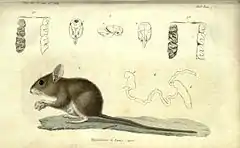| Eligmodontia | |||
| F. Cuvier, 1837[1] | |||
 Przedstawiciel rodzaju – gerbilomyszka pampasowa (E. typus) na ilustracji z 1837 roku | |||
| Systematyka | |||
| Domena | |||
|---|---|---|---|
| Królestwo | |||
| Typ | |||
| Podtyp | |||
| Gromada | |||
| Podgromada | |||
| Infragromada | |||
| Rząd | |||
| Podrząd | |||
| Infrarząd | |||
| Nadrodzina | |||
| Rodzina | |||
| Podrodzina | |||
| Plemię | |||
| Rodzaj |
gerbilomyszka | ||
| Typ nomenklatoryczny | |||
|
Eligmodontia typus F. Cuvier, 1837 | |||
| Synonimy | |||
|
| |||
| Gatunki | |||
| |||
Gerbilomyszka[6] (Eligmodontia) – rodzaj ssaków z podrodziny bawełniaków (Sigmodontinae) w obrębie rodziny chomikowatych (Cricetidae).
Zasięg występowania
Rodzaj obejmuje gatunki występujące w Ameryce Południowej[7][8][9].
Morfologia
Długość ciała (bez ogona) 64–103 mm, długość ogona 50–125 mm, długość ucha 10–26 mm, długość tylnej stopy 17–27 mm; masa ciała 9,4–35 g[8][10].
Systematyka
Rodzaj zdefiniował w 1837 roku francuski zoolog i paleontolog Frédéric Cuvier na łamach Annales des Sciences Naturelles[1]. Na gatunek typowy Cuvier wyznaczył gerbilomyszkę pampasową (E. typus).
Etymologia
Eligmodontia (Elygmodovtia, Elimodon, Heligmodontia, Eligmodon): gr. εΛιγμος eligmos ‘zakręt, skręt’; οδους odous, οδοντος odontos ‘zęby’[11].
Podział systematyczny
Do rodzaju należą następujące gatunki[12][10][7][6]:
- Eligmodontia hirtipes (O. Thomas, 1902) – gerbilomyszka chilijska
- Eligmodontia puerulus (R.A. Philippi, 1896) – gerbilomyszka punańska
- Eligmodontia bolsonensis Mares, Braun, Coyner & van den Bussche, 2008 – gerbilomyszka wyżynna
- Eligmodontia typus F. Cuvier, 1837 – gerbilomyszka pampasowa
- Eligmodontia dunaris Spotorno, Zuleta, L.I. Walker, Manriquez, Valladares & Marin, 2013
- Eligmodontia moreni (O. Thomas, 1896) – gerbilomyszka stokowa
- Eligmodontia morgani J.A. Allen, 1901 – gerbilomyszka patagońska
Uwagi
Przypisy
- 1 2 F. Cuvier. Du genre Eligmodonte et de l’Eligmodonte de Buenos-Ayres. Eligmodontia typus. „Annales des Sciences Naturelles, Zoologie”. Seconde Série. 7, s. 169, 1837. (fr.).
- ↑ A.F.A. Wiegmann. Bericht über die Leistungen in Bearbeitung der übrigen Thierklassen, während des Jahres 1837. „Archiv für Naturgeschichte”. 4 (2), s. 388, 1838. (niem.).
- ↑ J.A. Wagner. Gruppirung der Gattungen der Nager in natürlichen Familien, nebst Beschreibung einiger neuen Gattungen und Arten. „Archiv für Naturgeschichte”. 7 (1), s. 125, 1841. (niem.).
- ↑ Mammalia. W: L. Agassiz: Nomenclator zoologicus, continens nomina systematica generum animalium tam viventium quam fossilium, secundum ordinem alphabeticum disposita, adjectis auctoribus, libris, in quibus reperiuntur, anno editionis, etymologia et familiis, ad quas pertinent, in singulis classibus. Soloduri: Jent et Gassmann, 1842–1846, s. 37. (łac.).
- ↑ O. Thomas. On new small Mammals from the Neotropical Region. „The Annals and Magazine of Natural History”. Sixth Series. 18 (106), s. 307, 1896. (ang.).
- 1 2 Nazwy polskie za: W. Cichocki, A. Ważna, J. Cichocki, E. Rajska-Jurgiel, A. Jasiński & W. Bogdanowicz: Polskie nazewnictwo ssaków świata. Warszawa: Muzeum i Instytut Zoologii PAN, 2015, s. 247–248. ISBN 978-83-88147-15-9. (pol. • ang.).
- 1 2 C.J. Burgin, D.E. Wilson, R.A. Mittermeier, A.B. Rylands, T.E. Lacher & W. Sechrest: Illustrated Checklist of the Mammals of the World. Cz. 1: Monotremata to Rodentia. Barcelona: Lynx Edicions, 2020, s. 432. ISBN 978-84-16728-34-3. (ang.).
- 1 2 U. Pardiñas, P. Myers, L. León-Paniagua, N.O. Garza, J. Cook, B. Kryštufek, R. Haslauer, R. Bradley, G. Shenbrot & J. Patton. Opisy gatunków Cricetidae: U. Pardiñas, D. Ruelas, J. Brito, L. Bradley, R. Bradley, N.O. Garza, B. Kryštufek, J. Cook, E.C. Soto, J. Salazar-Bravo, G. Shenbrot, E. Chiquito, A. Percequillo, J. Prado, R. Haslauer, J. Patton & L. León-Paniagua: Family Cricetidae (True Hamsters, Voles, Lemmings and New World Rats and Mice). W: D.E. Wilson, R.A. Mittermeier & T.E. Lacher (redaktorzy): Handbook of the Mammals of the World. Cz. 7: Rodents II. Barcelona: Lynx Edicions, 2017, s. 517–519. ISBN 978-84-16728-04-6. (ang.).
- ↑ D.E. Wilson & D.M. Reeder (redaktorzy): Genus Eligmodontia. [w:] Mammal Species of the World. A Taxonomic and Geographic Reference (Wyd. 3) [on-line]. Johns Hopkins University Press, 2005. [dostęp 2020-12-03].
- 1 2 Class Mammalia. W: Lynx Nature Books: All the Mammals of the World. Barcelona: Lynx Edicions, 2023, s. 276. ISBN 978-84-16728-66-4. (ang.).
- ↑ T.S. Palmer. Index Generum Mammalium: a List of the Genera and Families of Mammals. „North American Fauna”. 23, s. 256, 1904. (ang.).
- ↑ N. Upham, C. Burgin, J. Widness, M. Becker, C. Parker, S. Liphardt, I. Rochon & D. Huckaby: Treeview of Mammalian Taxonomy Hierarchy. [w:] ASM Mammal Diversity Database (Version 1.11) [on-line]. American Society of Mammalogists. [dostęp 2023-10-08]. (ang.).